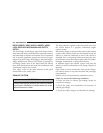
3. Ride comfort and vehicle stability
Proper tire inflation pressures contribute to the excellent
ride quality built into your vehicle. Over-inflation pro-
duces an uncomfortable and jarring ride.
Under-inflation can produce a feeling of sluggish re-
sponse.
Unequal inflation pressures can produce erratic and
unpredictable vehicle response to steering maneuvers.
The proper tire pressure for your vehicle is listed on a
placard attached near the door sill striker on the driver’s
side ‘‘B’’-Pillar.
The recommended inflation pressures should be followed
when the specified tires are installed.
Item Tire size Front Rear
Normal tire P205/60R16 91H 32 psi (220 kpa)
P215/50R17 90H 32 psi (220 kpa)
Compact spare tire T125/70D16 60 psi (420 kpa)
The pressures should be checked and adjusted, if neces-
sary, at least once a month.
Tire pressures should be checked more often when weather
temperatures vary widely, because tire pressures vary with
outdoor temperatures. Inflation pressures specified on the
placard are always “cold inflation pressure”.
Cold inflation pressure can be measured after the vehicle
has been stationary for at least three hours or driven less
than one mile (1.6 km) after being stationary for three
hours.
Cold inflation pressure must not exceed the maximum
values molded into the tire sidewall. After driving sev-
eral miles, tire inflation pressure may increase 2 to 6 psi
(14 to 41 kPa) over the cold inflation pressure; do NOT let
air out of the tires to match the specified cold pressure, or
your tires will be underinflated.
Check your tires each time you refuel. If one tire looks
lower than the others, check the tire inflation pressure for
all of them. The following precautions also should be
observed:
1. Keep your tires inflated to the pressures that are
recommended. (See the tire and loading information
placard attached the driver’s side ‘‘B’’-Pillar.)
2. Stay within the load limits that are recommended.
MAINTENANCE 335
9


















